SRAM Rival eTap AXS review
SRAM brings 'beep boop' shifting to a much more friendly price bracket
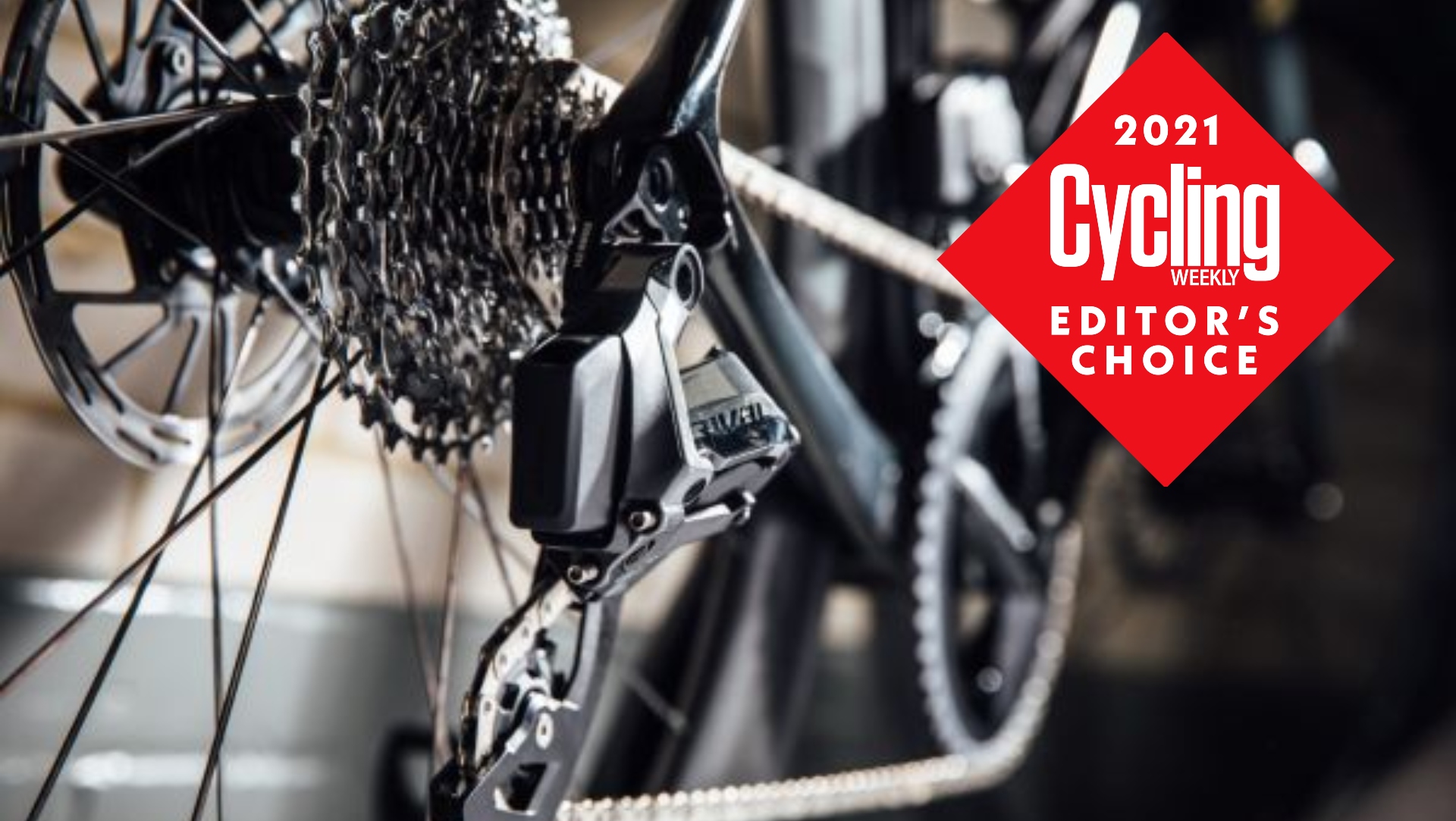
SRAM Rival eTap AXS brings all the benefits of the earlier (and much more expensive) releases - at a fraction of the outlay. It's not a lightweight choice, but it compares extremely well with Force eTap AXS in terms of grams gained and pounds saved. The longevity test will have to come at a later date - but so far, so incredibly good!
-
+
Wireless, electronic shifting
-
+
Value vs Force/Red
-
+
Inexpensive power meter upgrade
-
-
More weighty than mechanical, wired groupsets
-
-
You'll need an XDR-ready wheelset
You can trust Cycling Weekly.

SRAM's Rival eTap AXS burst onto the scene in April this year, bringing wireless, electronic, 12-speed shifting to a new audience, and simultaneously helping to quench the thirst of a component parched industry.
The American brand’s previous entry-level electronic groupset was Force eTap AXS, costing over £2,000. The Rival offering sets consumers back £1,314 for a 2x set up (or £1,102 for 1x).
"Nothing good comes for free" is a saying that's rarely exempt from product development - the use of more cost-effective materials means that Rival eTap AXS is heavier than the Force iteration, but only by around 200g. The functionality, however, holds a mirror up to Force and asks its bigger brother: “why so expensive?”
This review is based on a two-month riding period. Because more entry-level groupsets have a reputation for wearing quicker, we've removed the groupset from the test bike SRAM sent, and fitted it to a long termer bike for a further review - we'll update this post with our findings in six to 12 months time.
SRAM Rival eTap AXS: weight
Much was made of the weight of SRAM Rival eTap AXS at its launch, so I'll start there.
My test groupset included a 46/33 chainring set up with 10-36 cassette, and came in at 3,205g for £1,314/$1,420.
Our last Force groupset weighed 2,979g, costing £2,274/$3,210. So the gram increase per pound saved between Rival and Force, to me, seems minimal.
Electronic shifting is heavier than mechanical shifting. The claimed weight for a Shimano 105 disc brake mechanical groupset is 2,478g, for £799/$696.
If you're a weight weenie, then this groupset probably isn't for you. In the interest of total honesty, if I were building up my own bike, I would still build it with a mechanical groupset - but that's purely personal preference. For those less focused upon mass, wireless electronic shifting comes with the benefit of a cable stretch-free existence, easier set-up, and, as SRAM expressed in several social media replies, it does 'go beep boop'.
| Component | Weight | Row 0 - Cell 2 |
| Chainset - left crank | 532g | Row 1 - Cell 2 |
| Chainset - right crank and axle | 350g | Row 2 - Cell 2 |
| Rotor - 160mm x2 | 318g (159g each) | Row 3 - Cell 2 |
| 12 speed cassette | 340g | Row 4 - Cell 2 |
| Rear mech | 327g | Row 5 - Cell 2 |
| Front mech | 157g | Row 6 - Cell 2 |
| Batteries x2 | 50g (25g each) | Row 7 - Cell 2 |
| Rear caliper (no pads + bolts) | 119g | Row 8 - Cell 2 |
| Front caliper (no pads + bolts) | 117g | Row 9 - Cell 2 |
| Brake pads x4 | 88g | Row 10 - Cell 2 |
| 12 speed chain | 251g | Row 11 - Cell 2 |
| DUB bottom bracket | 14g | Row 12 - Cell 2 |
| Right lever | 245g | Row 13 - Cell 2 |
| Left lever | 244g | Row 14 - Cell 2 |
| Hydraulic cables uncut | 53g | Row 15 - Cell 2 |
| Total | 3205g | Row 16 - Cell 2 |
SRAM Rival eTap AXS: component break down
For a full breakdown of each SRAM Rival eTap AXS component, and how it compares to those higher up in the hierarchy, check out the SRAM Rival eTap AXS launch story.
If you'd like the TL;DR version: SRAM Rival eTap AXS is extremely similar to the highly regarded Force version, with some weight-adding adjustments here and there which have minimal effect on early ride functionality, though they may begin to show themselves in the form of longevity over long term riding.
There's a good degree of friendliness between SRAM Red eTap and Force in terms of cassette and chain compatibility, so it would make sense, where possible, to upgrade these over time to the lighter and usually harder-wearing counterparts, but there's no immediate need to do this.
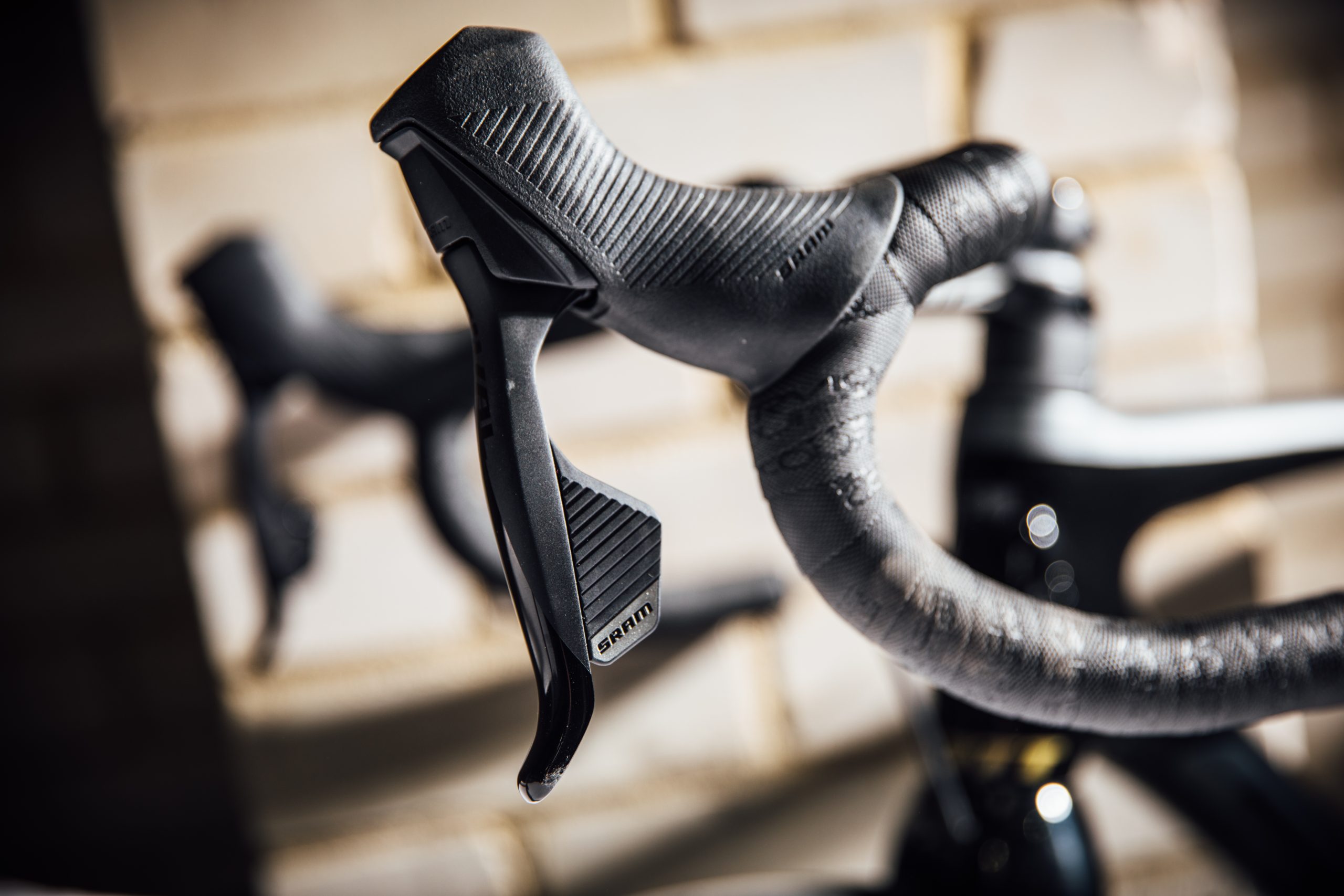
SRAM Rival eTap AXS: shifters, brake calipers
One of the greatest difficulties slowing down hydraulic groupset development on the road has been how to embed the system into a slimline road lever. On the mountain bike side, cable-actuated discs are unheard of on bikes costing more than £500 - and one day (hopefully) that'll be the case on the road.
As it stands, road hydraulic disc brake technology is constantly evolving, with shifter hoods decreasing in size with each new launch.
The Rival hoods are more compact than their more expensive siblings within Force and Red setups. That's because SRAM has removed functionality for auxiliary buttons used as sprint or TT bar end shifters. So, this groupset is a no-go for riders requiring those.
There's also no brake contact point adjustment, so you can't adjust how much pressure it takes to engage the pads. You can still adjust lever reach to cater for smaller hands, which I would wager is a more common adjustment.
The use of aluminium and steel, and no carbon, would have upped the weight but this remains similar to more expensive groupsets due to the decrease in overall size.
Not much has changed with the caliper, either - aside from the use of heavier materials, and a revised bleed port which now needs the bleed screw to be removed to attach a syringe.
SRAM still uses DOT fluid instead of mineral oil, which is what Shimano uses. The arguments for/against warrant an article of their own. DOT fluid is used in the automotive industry, it's not environmentally friendly and you don't want to get it on your hands.
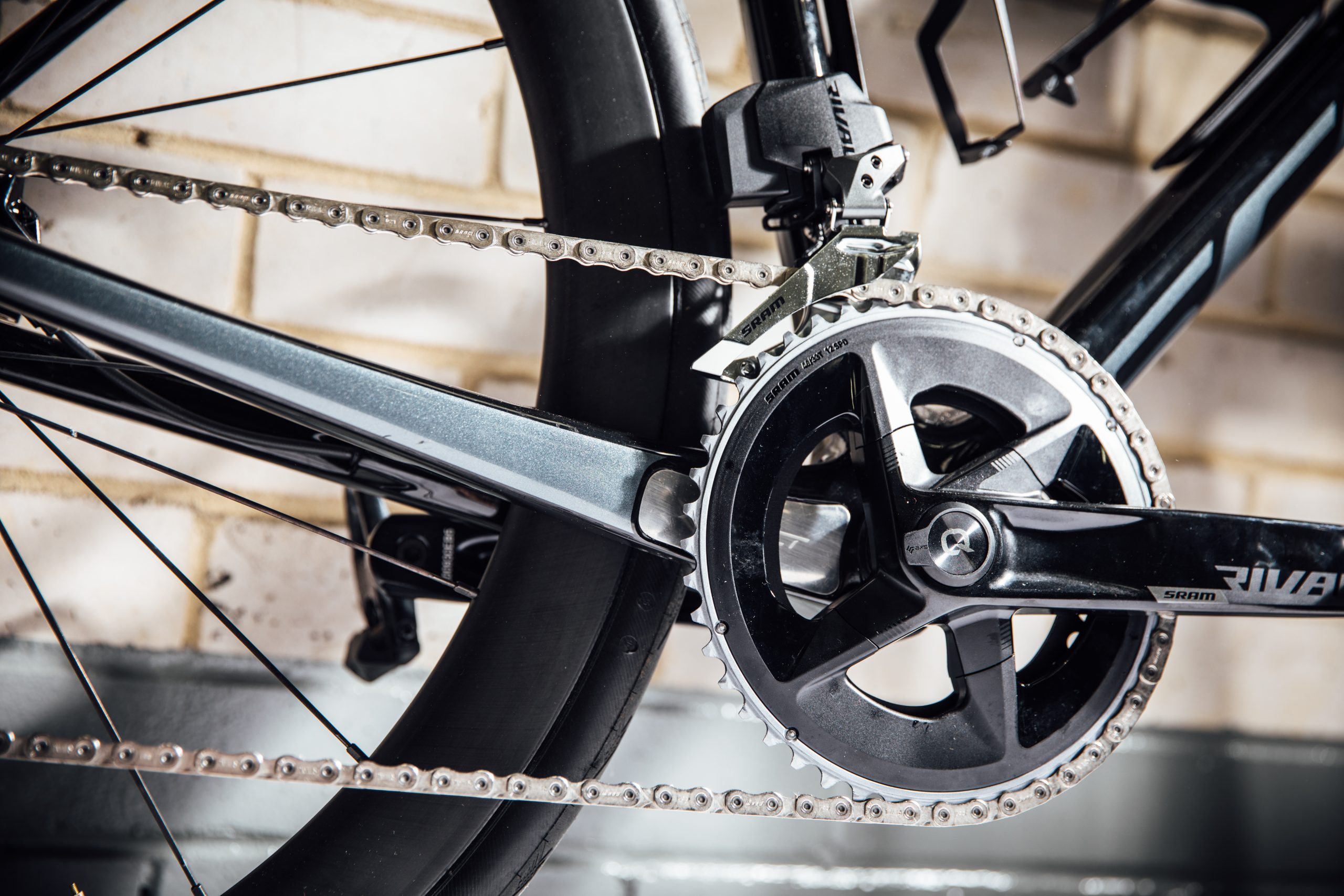
SRAM Rival eTap AXS: crankset, derailleurs, chain, cassette
Much of the weight difference between Rival and Force or Red is in the crankset, and that's because in this case, it's an entirely aluminium affair. It's built around a SRAM DUB bottom bracket.
Like all of the AXS groupsets, Rival uses SRAM's 'X-Range' gearing, with smaller chainrings and 12-speed cassettes providing riders with a wide range of gears.
In the case of Rival, cranksets come in a 48/35T or 46/33T, or you would be able to opt for the 'pro gearing', for something more racy if you wanted.
The 2x options uses a single integrated spider, so you can't transform it to a 1x version; there are also 1x specific options and a 'wide crankset' for those running gravel tyres - but that's not what we have on test here.
My test set-up comes with 165mm cranks; you can choose anything from 160mm to 175mm.
Cassettes range from 10-28 through to 10-33, the whole system is compatible with Force and Red options, and this is an area where you may want to upgrade in the future to drop a few grams and also increase longevity. There's no 10-26 in the Rival line-up and SRAM says its rear mech doesn't support this anyway.
To run SRAM eTap AXS, you will need a rear wheel with an XDR cassette body, which might present an issue if you're converting a bike you already have.
The chain is interchangeable with Force and Red and utilises the neat-looking flat top design, which promises greater efficiency, but in this case it is made from nickel and doesn't have the same finish as the more expensive versions which might last longer.
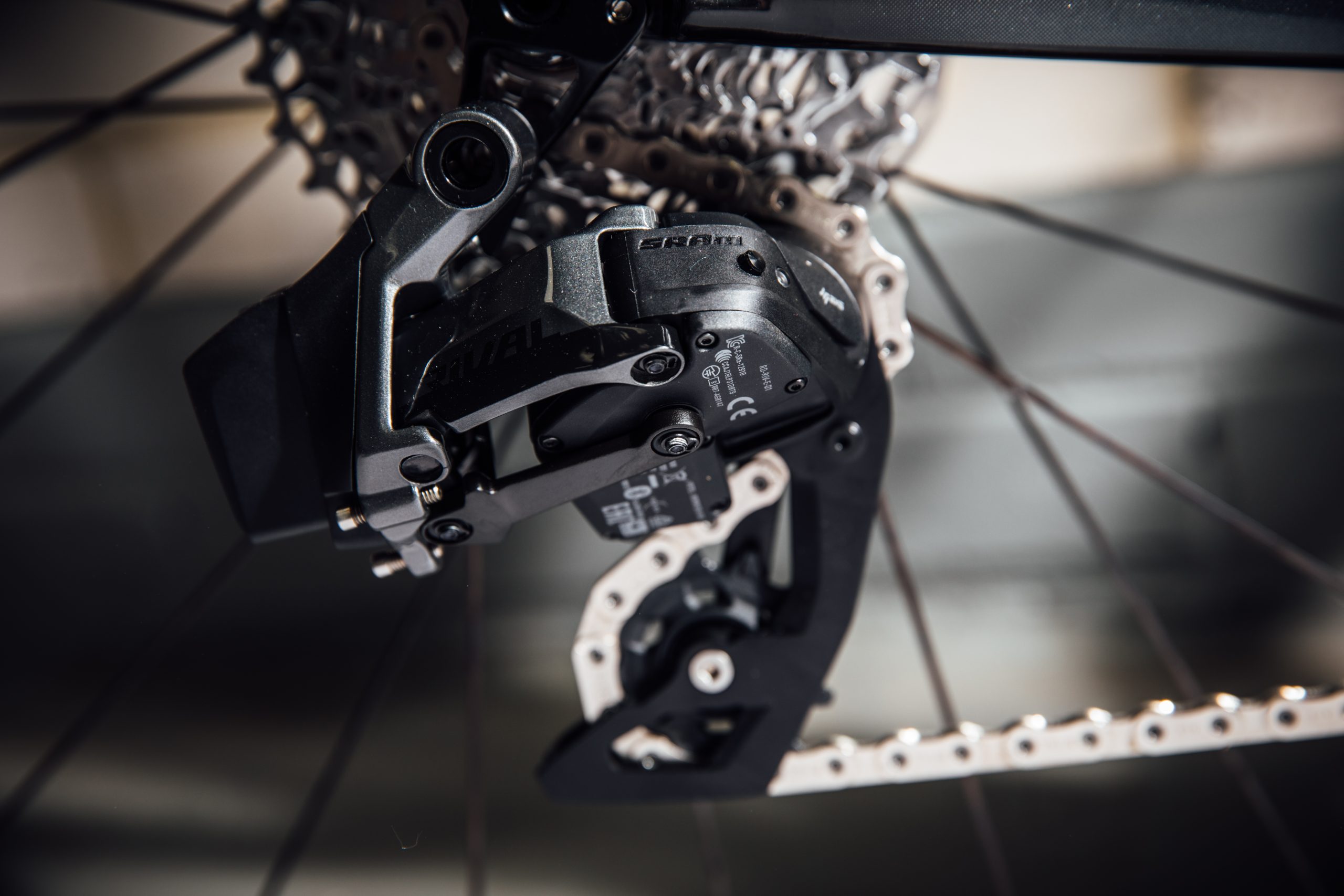
The mechs have the same bulky aesthetic as other eTap AXS groupsets, and no doubt this is an area for brands to work on slimming down in the future. A club mate did make the joke that I appeared to be carrying an integrated lunch box.
Sizeist sniggers aside, the battery design is excellent, it takes a fraction of a second to remove one and they can be plugged in at home. Battery indicator lights show how much juice you have left, and you can ride hundreds of kilometres without needing to worry.
The rear mech does not use the Orbit fluid dampener that you'll find on Red and Force, instead, it has a spring clutch to avoid chain clatter. Clutch rear mechs really come from mountain bike tech, on the road they're not particularly necessary. If you're using this groupset for gravel, it makes sense to have a clutch system but the spring mechanism used here proved sufficient.
Add a power meter
One of the stand-out inclusions in the birth of SRAM Rival eTap AXS was the addition of a single-sided Quarq power meter. Users can purchase this as standard, paying £322/$349 for the crankset, instead of £230/$249 - or upgrade later with a replacement left hand crank and spindle for £230. This is a major step forward for data-driven riders, which sees power meters become a much more accessible tool.
SRAM Rival eTap AXS: the ride
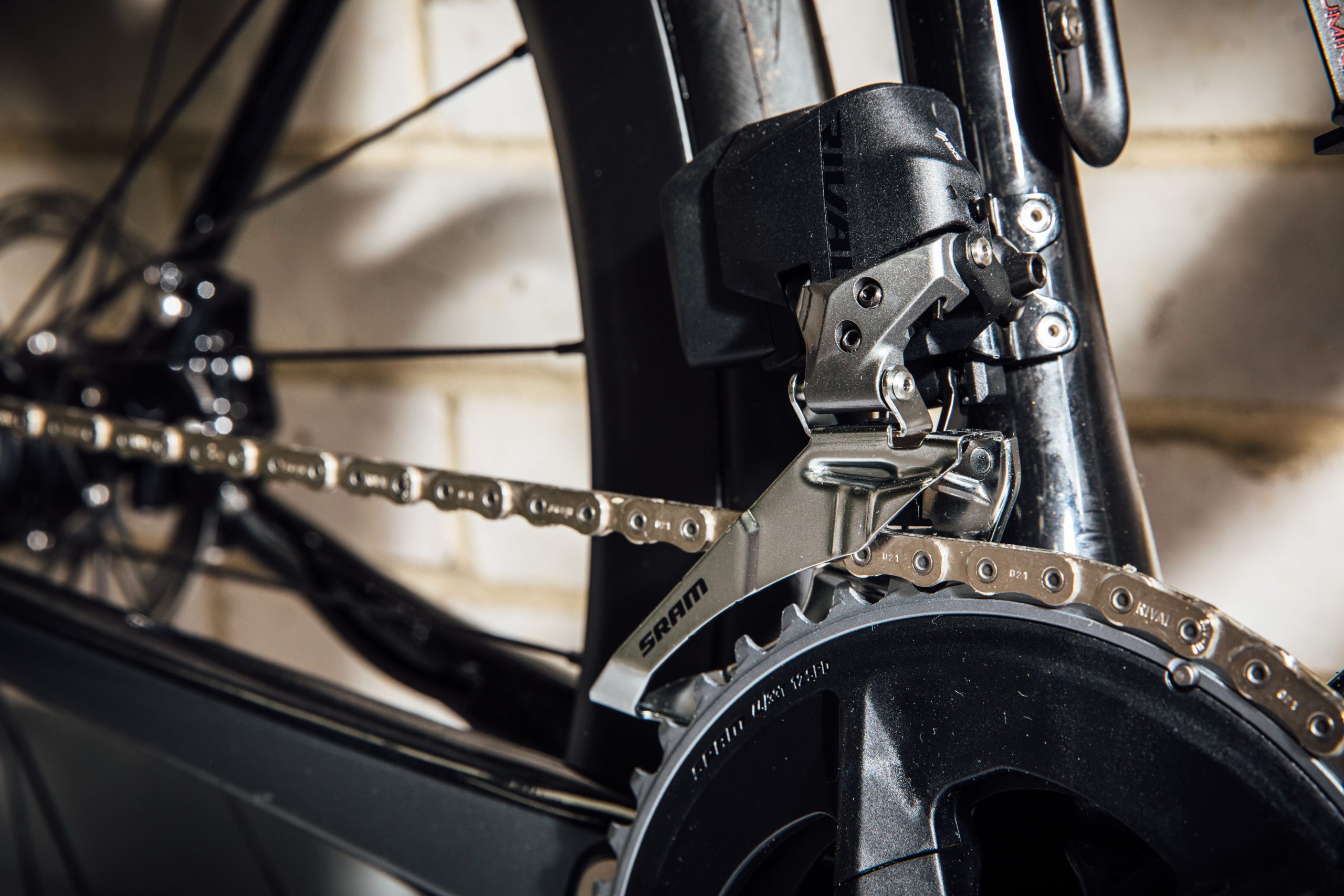
My test period with SRAM Rival eTap AXS started soon after jumping off the Liv Devote, which came with SRAM Force eTap AXS. In this case, the groupset was fitted to a Scott Addict road bike frame, with a 46/33 chainset, 10-36 cassette, 165mm and cranks.
The carbon frame came specced with Zipp's own aluminium finishing kit and the Zipp 303S wheelset (all of which, as a side note, really impressed me - particularly the wheels). The full build dropped onto the scales at 8.2kg.
My primary takeaway is that the difference between this set-up, and the more expensive Force, is minimal. The speed of shifting was not discernibly different, requiring a light tap to shift, which makes moving through the gears on variable terrain much simpler. The braking performance was, as you'd expect from newly, bedded-in hydraulic disc brakes, excellent.
I can't say that the slimdown in hood design was particularly striking, though I'm sure if I was going directly from one to the other the smaller outline would be preferable.
The 46/33 chainset paired with a 10-36 cassette provides a sub 1:1 ratio, which is significantly lower than my usual preference of a 52/36 and an 11-28. However, on steep climbs (living in a valley, there are plenty, in every direction) this really gave me the opportunity to knock back the effort when I wished.
At the top end of speed, whilst I had all the range I'd want for uphill sprints and rolling efforts, I was missing those 'flatstick effort' gears - the kinds you'd want to access during a race or chaingang. However, they'd be easily found in the 48/35 configuration.
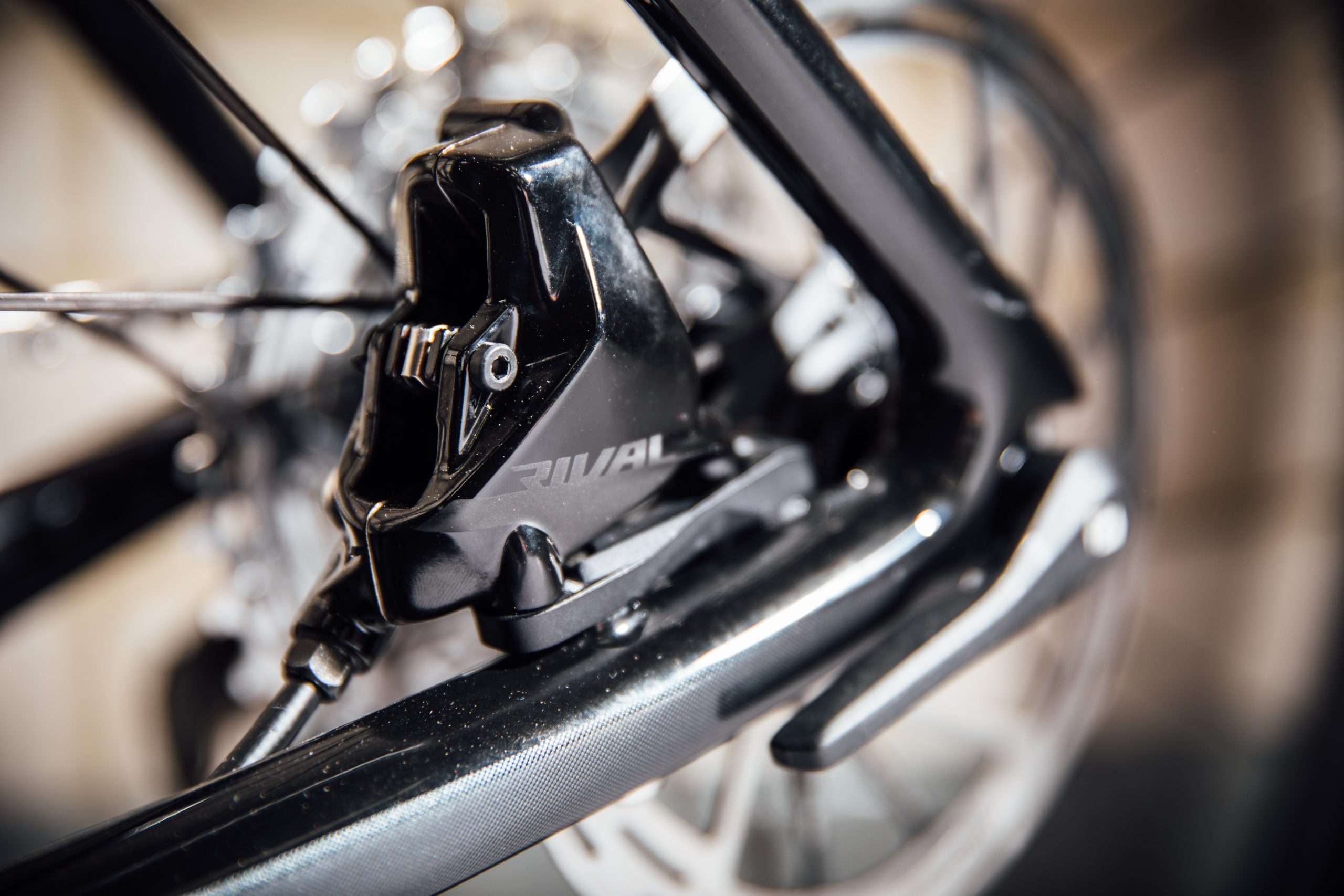
On the road, I didn't notice any chain clatter as a result of having the spring clutch over the pricier Orbit fluid dampner - and whilst I didn't attempt any gravel rides, I did career down Outwood Lane, from Bletchingley. If you don't know the area, imagine the surface of the moon after a workforce of Wombles has finished randomly drilling holes in it. Anyway - suffice to say, on terrible road surface, the chain was quiet enough.
When the juice needs a top up, unlike Shimano's Di2 system, there's no need to place the bike within reaching distance of a plug socket, the batteries snap out ready to be housed in a charger. Removal is so easy that a friend did once exemplify this by stealing one at the lights for a laugh, something to bear in mind if you’re security conscious and leaving your bike around at race HQs.
SRAM does provide an eTap AXS app, which lets you check up on firmware and also provides a little insight into how you're using your gears. The app is a nice touch, and connectivity was always quick, but with enough data available to paralyse myself out of actually riding the bike at all I tend to limit my app usage to the essentials, of which - SRAM has intentionally ensured - there are none.
I'm sticking with a groupset-only review for now, but the dual sided Quarq DZero impressed us at last test, and having had them on multiple test bikes I wouldn't dispute that good review.
SRAM Rival eTap AXS: value and conclusions
In terms of initial performance, the difference between SRAM Rival eTap AXS and SRAM Force eTap AXS is difficult to discern. Perhaps if I were to jump from one bike to the other, a few small tweaks here and there might show themselves, but allow a short window of time between tests and Rival feels pretty much identical.
Based upon that, Rival looks to be an excellent investment Its only real drawback is around 200g on Force, and it costs £1,000 less and I'll be the first to admit I could save that 200g elsewhere at a much lower cost.
Of course, Rival eTap AXS is still heavier than mechanical options. In the interest of total honesty, if I were building up my own bike, I would still build it with a mechanical groupset - but that's purely personal preference. Opting for eTap takes away crunchy gears, cable stretch and an awful lot of low level regular maintenance.
If you want electronic shifting but you don't want to make a heavy investment, based on the first few months of riding, this is where it's at. It remains to be seen if Rival has the staying power of its more expensive siblings - and we'll update this review with longer term impressions once we've had the chance to collect them.

Thank you for reading 20 articles this month* Join now for unlimited access
Enjoy your first month for just £1 / $1 / €1
*Read 5 free articles per month without a subscription

Join now for unlimited access
Try first month for just £1 / $1 / €1
Get The Leadout Newsletter
The latest race content, interviews, features, reviews and expert buying guides, direct to your inbox!
Michelle Arthurs-Brennan the Editor of Cycling Weekly website. An NCTJ qualified traditional journalist by trade, Michelle began her career working for local newspapers. She's worked within the cycling industry since 2012, and joined the Cycling Weekly team in 2017, having previously been Editor at Total Women's Cycling. Prior to welcoming her first daughter in 2022, Michelle raced on the road, track, and in time trials, and still rides as much as she can - albeit a fair proportion indoors, for now.
Michelle is on maternity leave from April 2025 until spring 2026.
-
 MAAP teams up with QUOC; first collab is the Gran Tourer XC shoe
MAAP teams up with QUOC; first collab is the Gran Tourer XC shoeDesigned for off-road riding the limited-edition shoe features a new colourway and other features
By Luke Friend Published
-
 'I may not have a ridden a bike, but I’m f*****g strong' - British gravel racer has unusual off-season ahead of Sea Otter Classic
'I may not have a ridden a bike, but I’m f*****g strong' - British gravel racer has unusual off-season ahead of Sea Otter ClassicAnnabel Fisher tells Cycling Weekly about her ski racing season ahead of returning to gravel
By Tom Thewlis Published
-
 'I hope it rains... there's little room for error' - British cycling legend on the prospect of a wet Paris-Roubaix
'I hope it rains... there's little room for error' - British cycling legend on the prospect of a wet Paris-RoubaixSean Yates says that inclement weather won't stop the favourites from winning Roubaix, but that it'll add a bit more excitement
By Adam Becket Published